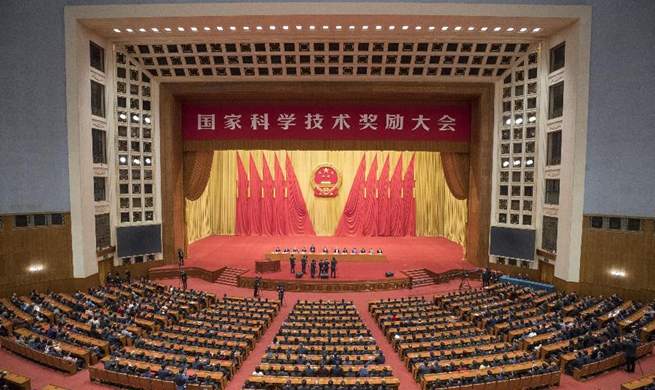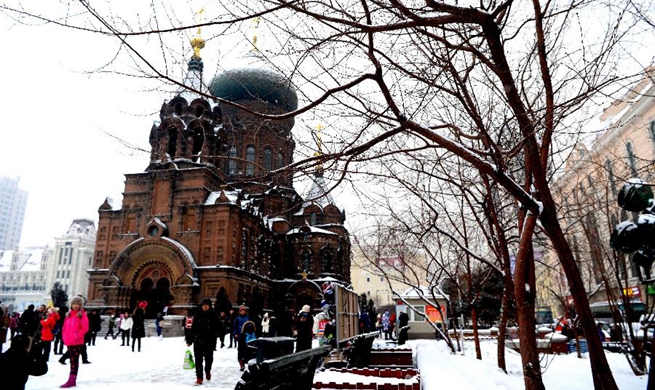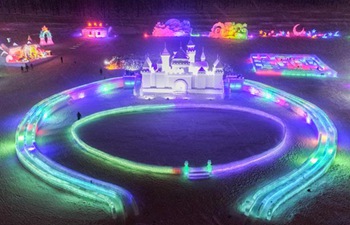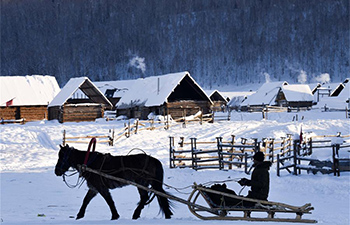by Liu Chuntao, Naim-Ul-Karim
DHAKA, Jan. 8 (Xinhua) -- Every day, hundreds of local and foreign tourists visit an archaeological site with unique architectural features which a joint team of archaeologists from Bangladesh and China have unearthed.
The site contains the remains of a Buddhist town and temple at Nateshwar, the present day location of which is in the Bikrampur area of Bangladesh's Munshiganj district, 30 km south of the capital city of Dhaka.
The archeological site is the remains of temple and city thought to be 1,000 years old.
The old ruins, still being excavated by the joint team of Bangladeshi and Chinese archaeologists, are one of the major recent archaeological discoveries in Bangladesh.
The Buddhist historical site featuring unique architectural elements has been discovered about seven meters beneath the ground. Atish Dipankar, known as a venerated Buddhist scholar and philosopher, is thought to have spent his early life here.
Deputy Chief of Mission at the Chinese embassy in Dhaka, Chen Wei, and Bangladeshi and Chinese archaeologists recently visited the excavation site.
The excavation has already unearthed several valuable artifacts from this renowned archaeological site, including a prayer hall, mortar floor, octagonal stupas, pot shreds, baked clay materials and burnt bricks.
Prof. Sufi Mostafizur Rahman, who is leading the excavation team comprised of researchers from Bangladesh and China, said carbon-14 tests on 26 unearthed relics at a Beta Laboratory in the United States had proved that the archaeological site was more than 1,100 years old.
He has sought further Chinese support to continue the excavation activities.
He expressed hope that the site, with proper conservation, will emerge as an attractive tourist site since Buddhist scholar Atisha Dipankar's ancestral house is located there.
Shahnaj Husne Jahan, a professor and director at the Center for Archaeological Studies at the leading private University of Liberal Arts Bangladesh, described the site as a unique one and said it could be another world heritage site if it is conserved properly, although this may take time.
But inadequate funding and technology have hindered the excavation processes. "That's why we need more Chinese support," she said, adding that this is going to be the heart of Buddhist heritage tourism in this part of the world.
Archeological research at the site began in 2010 and a series of significant results have been achieved since then.
It is believed that this discovery will offer interesting glimpses into the early life of Atish Dipankar. During the 10th-11th Century, he was known in Bangladesh, India, China and other Asian countries as a saint-philosopher by virtue of his unique character, erudition, scholarly attributes, and spiritual eminence.
Because of his outstanding knowledge and wisdom, he was named Atish Dipankar Srigyan, which means "glorious wisdom source of light." He has been venerated for nearly 1,000 years as an outstanding personality.
He wrote more than 200 Buddhist books and was also known as a translator, popularized medical science and built reservoirs.
But the great philosopher was forgotten for centuries in a peculiar twist of history in the land of his birth, Bangladesh, as well as in the Indian sub-continent until the end of the 19th century.
After Atish Dipankar was "rediscovered" in his motherland nearly 1,000 years after he left Bangladesh for China's Tibet to introduce the Buddha's teachings and passed away there, China offered to return part of his ashes to Bangladesh.
Both Dhaka and Beijing said Atish is now a symbol of a stronger "China-Bangladesh relationship."
A mausoleum has already been built in the village of his birth with the support of China.
Chen Wei said this is the best final resting place for the venerable master.
"This is also proof that Bangladesh and China have shared very strong cultural links since long ago," Chen said.
He said that the Institute of Cultural Relics and Archaeology of Hunan province is involved in the excavation and their personnel are doing a great job.
"I think it also promotes even more understanding between China and Bangladesh as well as the heart-to-heart and people-to-people contact between Chinese and Bangladeshi people."
The Chinese embassy will work together with the Bangladesh side to promote this site to become a common wealth of Bangladesh and China, he said.

















